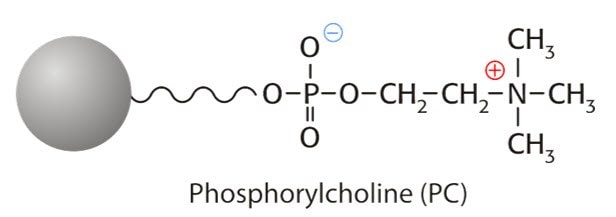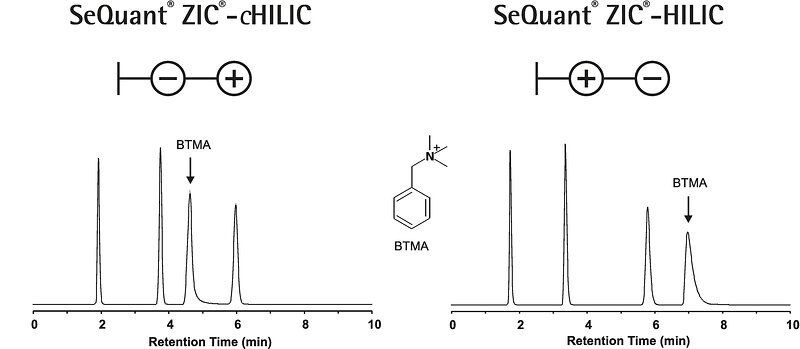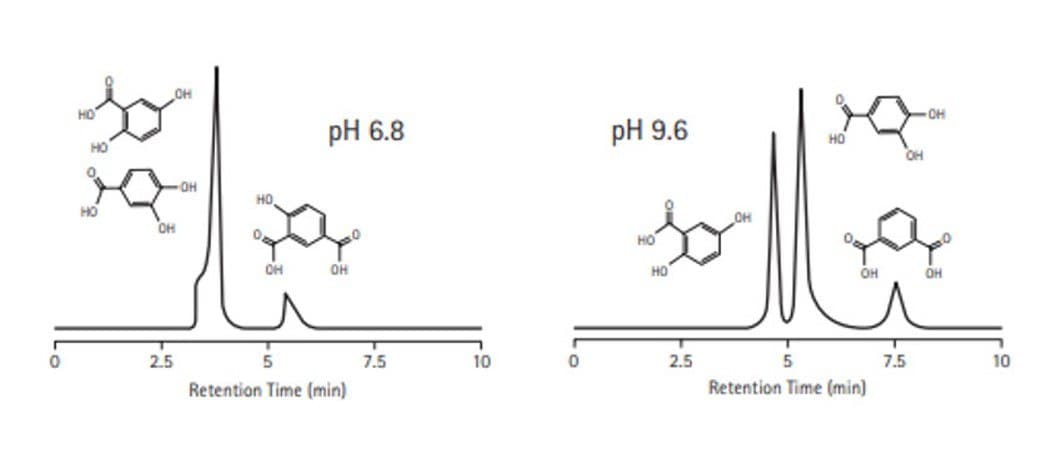SeQuant® HILIC HPLC Columns
Section Overview
- Complete Range for Separations of All Polar Hydrophilic Compounds
- SeQuant® ZIC®-HILIC
- SeQuant® ZIC®-cHILIC
- SeQuant® ZIC®-pHILIC
- SeQuant® ZIC®-HILIC and ZIC®-cHILIC Capillary Columns
- Related Products
Complete Range for Separations of All Polar Hydrophilic Compounds
SeQuant® HILIC (hydrophilic interaction liquid chromatography) HPLC columns constitute a range of high-performance tools for separating polar hydrophilic compounds. All columns carry densely bonded, truly zwitterionic functional groups with a charge balance of 1:1. Separation is achieved by hydrophilic partitioning combined with weak ionic interactions for maximum selectivity, high loadability and easy optimization of methods.
Features and Benefits
- High-performance HPLC and LC-MS separations of polar hydrophilic compounds
- Zwitterionic stationary phase ensures reproducible retention
- Two complementary phase chemistries
- Maximum LC-MS compatibility with minimized column bleed
- Excellent reproducibility and robustness
- Available in a variety of lengths, particle sizes, and pore dimensions

The ZIC®-HILIC Column is designed to retain and separate all types of polar and hydrophilic compounds and for robust chromatography with high selectivity and reproducibility. The silica-based ZIC®-HILIC sorbent has a bonded stationary phase consisting of a highly polar, permanent zwitterion. Separation selectivity is favored by the 1:1 zwitterion charge balance, which makes the ZIC®-HILIC Column overall neutral, with weak, but important, ionic interactions. Tuning of the selectivity on the ZIC®-HILIC Column during method development is facilitated by the pH-inpendent permanent zwitterion, ensuring that only the analytes (and not the column) is affected during eluent optimization.

SeQuant® ZIC®-cHILIC is designed for excellent HPLC and LC-MS of polar hydrophilic compounds. This new zwitterionic stationary phase with phosphorylcholine functional group provides you with complementary selectivity for easier method development for substances that have been difficult to separate by previous types of HPLC columns operated in reversed-phase or HILIC mode.

Isocratic separations of the positively charged benzyltrimethylamine (BTMA, peaks indicated with arrows) and the neutral toluene (void marker), uracil and cytosine on ZIC®-cHILIC (left) and ZIC®-HILIC (right) illustrating differences and similarities in selectivity caused by the different charge orientation of the zwitterionic functional groups (see illustrations). Column dimensions were 100 x 4.6 mM, particles size 3 or 3.5 µm, and pore size 100 Å. Eluent was 80 : 20 acetonitrile/ 25 mM aqueous ammonium acetate pH 6.8 pumped at 0.5 mL/min at 23 °C. Detection by UV absorption at 254 nm.
SeQuant® ZIC®-pHILIC
The ZIC®-pHILIC stationary phase has the same highly polar, bonded, permanent zwitterion, functional group as the silica based ZIC®-HILIC Column. The user can therefore expect the same selectivity, however, with a trade-off in flow-rate range, and separation efficiency, common with polymeric materials. The more durable support allows for use in an extended pH range, which can be beneficial for certain applications.
Example of enhanced selectivity at high pH The application example below illustrates how the selectivity of the ZIC®-pHILIC material can be enhanced by performing the separation at elevated pH. The chromatograms show isocratic separations of gentisic acid, protocatechuic acid and isophthalic acid on a ZIC®-pHILIC Column. The pH-increase also results in higher retention and improved peak shape for these analytes.

SeQuant® ZIC®-HILIC and ZIC®-cHILIC capillary columns
The new SeQuant® ZIC®-HILIC and ZIC®-cHILIC capillary columns are now housed in advanced glass-lined hardware, significantly enhancing their capability to separate a wide array of hydrophilic bio-related molecules, including phosphorylated compounds and peptides. These columns are particularly suited for applications in OMICS fields such as proteomics, metabolomics, and glycomics, where they have demonstrated exceptional performance.
The upgraded hardware, along with an enhanced packing procedure, offers superior reproducibility and stability compared to existing capillary columns.
HILIC columns serve as an ideal complement to reversed-phase liquid chromatography (RPLC) for two-dimensional liquid chromatography (2D-LC). The zwitterionic (ZIC®) HILIC column effectively retains hydrophilic peptides and improves resolution for polar modifications, while the C18 column excels in retaining hydrophobic peptides, facilitating comprehensive analysis of protein digests.
For more information, check out the product flyer for the SeQuant® ZIC®-HILIC and ZIC®-cHILIC Capillary Columns. Additionally, you can explore our white paper on LC-MS/MS characterization of trypsin-cleaved proteins using capillary columns.
To continue reading please sign in or create an account.
Don't Have An Account?